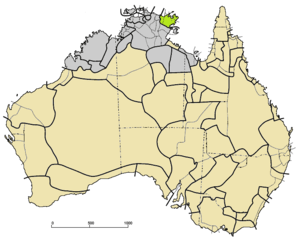Yolŋu languages
| Yolŋu Matha | |
|---|---|
| Yuulngu | |
| Geographic distribution: | Northern Territory, Australia |
| Linguistic classification: |
|
| Subdivisions: |
Signed form: Yolŋu Sign Language |
| Glottolog: | yuul1239[1] |
|
Yolŋu languages (green) among other Pama–Nyungan (tan) | |
Yolŋu Matha is a cover term for the languages of the Yolngu (Yolŋu, Yuulngu), the Indigenous people of northeast Arnhem Land in northern Australia. (Yolŋu = people, Matha = tongue, language).
Yolngu languages have a fortis–lenis contrast in plosive consonants. Lenis/short plosives have weak contact and intermittent voicing, while fortis/long plosives have full closure, a more powerful release burst, and no voicing.
Varieties
Yolŋu Matha consists of about six mutually intelligible languages divided into about thirty clan varieties and perhaps twelve different dialects, each with its own Yolŋu name. Put together, there are about 4600 speakers of Yolŋu Matha. While there is extensive variation between these dialects, there is generally common mutual intelligibility, hence the umbrella group of Yolngu Matha. The linguistic situation is very complicated, since each of the 30 or so clans also has a named language variety. Dixon (2002) distinguishes the following:[2]
| Dhaŋu/Djangu | Nhaŋu/Jarnango (Golpa) | Dhuwal (Dhay'yi, Gupapuyngu) | Ritharrŋu | Djinaŋ | Djinba |
|---|---|---|---|---|---|
| Wan.gurri | Gamalaŋga | Gupapuyngu | Ritharngu | Yirritjing | Ganhalpuyngu |
| Lamamirri | Gorryindi | Gumatj | Wagilak | Wurlaki | Manjdjalpuyngu |
| Rirratjingu | Mäḻarra | Djambarrpuyngu | Djardiwitjibi | ||
| Gaalpu | Bindarra | Djapu | Mildjingi | ||
| Ngayimil | Ngurruwulu | Liyagalawumirr | Balmbi | ||
| Warramiri | Walamangu | Guyamirlili | Djuwing | ||
| Mandatja | Dhalwangu | Marrangu | |||
| Djarrwark | Murrungun | ||||
| Manyarring |
Bowern (2011) adds the varieties in parentheses as distinct languages.
Phonology
Consonants
The basic consonant inventory is common across Yolŋu varieties. However, some varieties do differ.[3]
| Peripheral | Apical | Laminal | Glottal | ||||
|---|---|---|---|---|---|---|---|
| Bilabial | Velar | Alveolar | Interdental | Retroflex | Palatal | Glottal | |
| Lenis | b /b/ | g /ɡ/ | d /d/ | dh/d̪/ | d̠ /ɖ / | dj /ɟ/ | ' /ʔ/ |
| Fortis | p /p/ | k /k/ | t /t/ | th/t̪/ | t̠ /ʈ / | tj /c/ | |
| Nasals | m /m/ | ŋ /ŋ/ | n /n/ | nh /n̪/ | n̠ /ɳ / | ny /ɲ/ | |
| Rhotics | rr /ɲ/ | r /ɹ/ | |||||
| Laterals | l /l/ | l̠ /m/ | |||||
| Approximants | w /w/ | y /j/ | |||||
Vowels
| Front | Central | Back | |
|---|---|---|---|
| Close | i /i/, e /iː/ | u /u/, o /uː/ | |
| Open | a /ɡ/, ä /aː/ |
A three-way vowel distinction is shared between Yolŋu varieties, though not all Yolŋu varieties have a contrast in length. In the varieties that do have a length contrast, long vowels occur only in the initial syllable of words.[4]
In popular culture
The films Ten Canoes (2006) and Charlie's Country (2013), both directed by Rolf de Heer and featuring actor David Gulpilil, feature dialogue in Yolŋu Matha. Ten Canoes was the first feature film to be shot entirely in Australian indigenous languages, with the dialogue largely in the Ganalbiŋu variety of Yolŋu Matha.
Geoffrey Gurrumul Yunupingu is a popular Australian singer who sings in the Gumatj dialect of Yolŋu Matha, as did the Aboriginal rock group Yothu Yindi.
Dictionaries and resources
Dictionaries have been produced by Beulah Lowe, David Zorc and Michael Christie. A free, web-based searchable dictionary created by John Greatorex was launched in February 2015 by Charles Darwin University.
There are also several grammars of Yolŋu languages by Jeffrey Heath, Frances Morphy, Melanie Wilkinson and others.[5]
A Graduate Certificate in Yolŋu Studies is offered at Charles Darwin University, teaching Yolŋu kinship, law and the Gupapuyŋu language variety.
ABC Indigenous News Radio broadcasts a news program in Yolngu Matha and also in Warlpiri on weekdays. The Aboriginal Resource and Development Services (ARDS) broadcast live radio in northeast Arnhem Land, Darwin and Palmerston and provide recordings of past programs on the internet.
Words and expressions
- Gakal = skill, talent, ability
- Gapumirr = with water (bucket with water), watery.[6]
- Manymak = Good, OK
- Yow (pronounced 'Yo') = Yes
- Yaka = No
- Yothu = Child
- Yindi = Big
- Yothu Yindi = denotes the link between two different entities which is characterised as a mother-child relationship[7]
References
- ↑ Hammarström, Harald; Forkel, Robert; Haspelmath, Martin; Bank, Sebastian, eds. (2016). "Yuulngu". Glottolog 2.7. Jena: Max Planck Institute for the Science of Human History.
- ↑ Dixon, R. M. W. (2002). Australian Languages: Their Nature and Development. Cambridge University Press. p. xxxvi.
- ↑ Wilkinson, Melanie (2012). Djambarrpuyŋu: A Yolŋu Variety of Northern Australia. Muenchen: Lincom Europa. pp. 44–45. ISBN 978-3-86288-360-8.
- ↑ Wilkinson, Melanie (2012). Djambarrpuyŋuː A Yolŋu Variety of Northern Australia. Muenchen: Lincom Europa. pp. 44–45. ISBN 978-3-86288-360-8.
- ↑ ARDS Language Publications
- ↑ Trudgen, Richard, 2000, 'Thirteen years of wanting to know', Why warriers lie down and die, Adoriginal Resource and Development Services, Inc. Darwin, pp. 97-112
- ↑ Christie, Michael J. (2013). Yolŋu language and culture: Study Notes. Darwin, Australia: Yolŋu Studies, Charles Darwin University. p. 40. ISBN 978-1-921576-20-1.
- Yolngu.net: grammar, vocabulary, history
- Aboriginal Resource and Development Services (ARDS)
- Charles Darwin University, Darwin, Yolŋu Matha course
- ARDS Rhombuy Dhäwu: Legal English-Yolngu Matha Online Dictionary
- Trudgen, Richard, Why Warriors Lie Down & Die , ARDS, Darwin, 2000.
- Examples of Yolngu Matha being spoken
- Radio National story
- Watson, Helen and David Wade Chambers (with the Yolngu community at Yirrkala). Singing the Land, Signing the Land. Deakin University.
- Madayin Law in Yolngu and English
